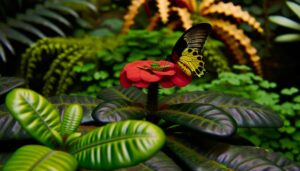Eastern Tiger Swallowtail Butterflies of Tennessee: Guide!
The Eastern Tiger Swallowtail (Papilio glaucus), prevalent in Tennessee, features yellow and black striped wings with a wingspan ranging from 3.1 to 5.5 inches.
Females display pronounced blue scaling on their hindwings. These butterflies thrive in deciduous woodlands, river valleys, and suburban gardens.
Their life stages include egg, larva with five instars, pupa, and adult, where they’re essential pollinators for Milkweed, Joe-Pye Weed, and Lilac. Habitual mud-puddling behavior aids nutrient intake.
By pollinating specific flowering plants like the Tulip Poplar, they bolster biodiversity and ecological stability. They exemplify adaptability and ecological significance in Tennessee’s landscapes, hinting…

Key Takeaways
Identification and Appearance
The Eastern Tiger Swallowtail butterfly, Papilio glaucus, exhibits distinct yellow and black striped wings with a wingspan ranging from 3.1 to 5.5 inches.
The forewings display four black stripes on a vivid yellow background, while the hindwings are adorned with blue and orange spots near the tail.
Females often show more prominent blue scaling on the hindwings, distinguishing them from males. The body is robust, black, with yellow spots running along the sides.
The antennae are clubbed, facilitating efficient navigation. This species’ coloration provides both camouflage against predators and a stunning sight for observers.
In flight, these butterflies’ graceful movements and striking appearance capture the essence of natural freedom and beauty, making them a mesmerizing subject for entomologists and nature enthusiasts alike.
Life Cycle Stages
Observing the Eastern Tiger Swallowtail’s striking appearance leads naturally to an exploration of its fascinating life cycle stages, beginning with the egg. Females lay tiny, spherical eggs on host plants. These eggs hatch into larvae, which undergo five instar stages.
The caterpillars are initially brown and mimic bird droppings for camouflage but later turn bright green with eye spots to deter predators.
Each stage is essential for survival and reproduction.
- Egg: Laid singly, pale green, and round.
- Larva: Transforms through five instars, growing larger and changing color.
- Pupa: Encases itself in a chrysalis, which can be brown or green, blending with surroundings.
- Adult: Emerges as a butterfly with a wingspan of 3.5 to 6.5 inches, ready to pollinate flowers.
Habitat and Distribution
Inhabiting diverse environments, Eastern Tiger Swallowtail butterflies thrive in deciduous woodlands, river valleys, and suburban gardens across Tennessee. Their broad distribution results from their adaptability to various altitudes and climatic conditions.
Observations reveal a preference for habitats with abundant flowering plants, providing essential nectar sources.
Researchers note their frequent presence along forest edges and open fields, where sunlight and floral diversity are ideal. Riparian zones offer critical resources, including moisture and host plants for larvae.
Urban and suburban gardens, with a mix of native and ornamental plants, attract these butterflies, facilitating their widespread presence.
This adaptability underscores their resilience and highlights the importance of preserving natural habitats and promoting biodiversity in managed landscapes.
Behavior and Diet
Eastern Tiger Swallowtail butterflies exhibit intricate foraging behaviors, frequently visiting a variety of nectar-rich flowers to sustain their energy needs. They’re often observed engaging in proboscis extension, a behavior where they uncoil their proboscis to access nectar.
These butterflies demonstrate preference for:
- Milkweed: Known for its high nectar content.
- Joe-Pye Weed: A tall perennial that attracts with its pinkish-purple flowers.
- Butterfly Bush: Offering abundant clusters of tubular flowers.
- Lilac: Providing a potent, sweet fragrance.
Their diet isn’t limited to nectar; they also consume minerals from mud puddles, a behavior called mud-puddling. This activity supplements essential nutrients like sodium and amino acids, important for reproduction and survival.
These behaviors highlight their adaptability and resourcefulness in diverse Tennessean landscapes.
Ecological Importance
In addition to their diverse foraging behaviors, Eastern Tiger Swallowtail butterflies play a crucial role in the ecosystem by pollinating a wide array of flowering plants throughout Tennessee.
These butterflies exhibit high fidelity to specific flower species, ensuring effective pollination. Their activities contribute significantly to the reproductive success of many angiosperms, enhancing biodiversity and ecological stability.
| Flowering Plant | Pollination Period | Pollination Impact |
|---|---|---|
| Tulip Poplar | Spring | High |
| Wild Cherry | Spring | Moderate |
| Joe Pye Weed | Late Summer | Significant |
| Butterfly Bush | Summer | High |
Conclusion
Coincidentally, the Eastern Tiger Swallowtail butterflies’ vibrant presence in Tennessee coincides with the blooming of native flora, symbolizing nature’s intricate synchronicity. Their graceful flight patterns add a mesmerizing touch to the landscape, effortlessly weaving through gardens and woodlands. Alongside them, the zebra swallowtail state butterfly, Tennessee’s official butterfly, thrives among the pawpaw trees, which serve as its primary host plant. Together, these remarkable species highlight the state’s rich biodiversity and the delicate balance between pollinators and native flora.
Their striking appearance, complex life cycle, specific habitat preferences, and unique behaviors all contribute to their vital ecological role.
Observing these butterflies reveals the delicate balance within Tennessee’s ecosystems, reminding us of the interconnectedness of all species. Their existence isn’t just a wonder of nature but a confirmation of the importance of biodiversity.






